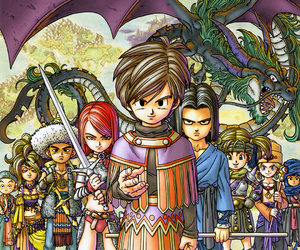Vocation system
The vocation system is a recurring gameplay mechanic in Dragon Quest series that determines character growth and abilities. The basic concept of the system is that instead of having pre-determined skills and stats, player characters are blank slates whose growth, abilities and role are determined by the player's choice of character class. Each class, or vocation, grants different attributes and characteristics throughout the game. The mechanic is governed by a set of rules and requirements for changing a given character's vocation, which can vary from game to game.
Only certain games within the series use a vocation system, with others having traits permanently fixed to characters. The system is always tied to the Alltrades Abbey present in the respective games, wherein characters can switch professions or combine past experiences to unlock advanced positions.
Dragon Quest III: The Seeds of SalvationEdit
Vocations make their proper series debut in the third title, wherein the concept of a vocation totally defines a character's abilities. Unless various stat-boosting seeds or personality-altering books are read in the remakes, any character in a given vocation is identical to the another of the same profession.
In III, the player begins with only the Hero and can enlist up to three additional party members from Patty's Party Planning Place. These characters represent different vocations and it is up to the player to decide what party members they want for their team, and at any time the player can leave and replace party members there. Each of the jobs has its own strengths and weaknesses which allows the player to build a team based on their own preferences. The party members who are kept in the tavern will depart the team with whatever stats and equipment that they gained during their travels.
About one-third of the way through the game, the player will reach Alltrades Abbey which will allow the player to change a character's vocation. Changing vocations drops a character to level 1 with half of their previous stats (and all learned spells if any), allowing particularly patient players potential to develop a perfect character without resorting to seed searching. The Sage is a hidden vocation unlocked by bringing the Words of Wisdom to the abbot or through getting a Gadabout to level 20. The Hero cannot change class at any time.
Dragon Quest VI: Realms of RevelationEdit
In VI, Alltrades Abbey is unlocked by completing the first section of the game and defeating Murdaw in the Lower World. Because the game's cast is comprised of pre-established characters with distinct personalities and stat growth tables, vocations affect a character's capabilities through percentages rather than hard numbers. For example, if Ashlynn's wisdom is 100 when she has no vocation, having her undertake the path of a mage will grant a 20% boost to the stat and raise it to 120. Such changes are adjusted with natural increases awarded through leveling up, and will be removed if the vocation is switched.
Unlike in III, this game starts with nine available classes. Each of the classes has eight ranks that can be reached by battling the required number of monsters, unlocking new abilities at each interval. Through mastering the initial jobs, advanced classes can be unlocked for that character which combine aspects of the prerequisites. For example, mastering the Warrior and the Martial Artist classes will allow the character to become a Gladiator. Skills and spells mastered in one profession are permanently learned by a character.
Dragon Quest VII: Fragments of the Forgotten PastEdit
The vocation implementation remains mostly unchanged from the previous game, though in the original PSX version there existed hybrid abilities that were unlocked through mastering certain positions sequentially. For example, a character could master Sword Dance by mastering the Warrior vocation right after the Dancer. This aspect was removed in the 3DS remake, with the hidden abilities being incorporated into the normal repertoire.
Additionally, party members can also become monsters by using Monster Hearts. By putting a monster heart in their inventory and speaking to the abbot or High Priestess Jacqueline, they can become that monster. In the PSX version the character would not take on the appearance of the monster until mastering the vocation, where as they immediately become beastly in the remake. Furthermore, monster classes are the only way to permanently learn advanced skills and spells in the remake. In all, there are over fifty classes that a single character can become in VII.
Dragon Quest IX: Sentinels of the Starry SkiesEdit
IX has a system which is similar to the one in III, in which a vocation defines a character and where the player may create party members and add them to the party. This can be done at the Quester's Rest located in Stornway, by speaking to Patty. Party members created do not play any significant part in the plot.
Vocations can be changed at the Alltrades Abbey, after the player has rescued Abbot Jack. There is no minimum level limit for changing classes, dubbed re-vocating. One notable difference from past games is that spells are no longer carried over between class changes. A character must be a specific class to use that classes spells. Skills do carry over, and there are also methods for utilizing each weapon type with all classes.
Additional vocations must be unlocked by doing quests before the player can switch to them. Notably, the Sage class is accessible only later in the game, but includes a specific ability, Jack's Knack, which allows the party members to change class at any time and place.
There are a total of 12 classes available in IX.
Related articlesEdit
GalleryEdit
Maribel modeling all human vocations available in VII
